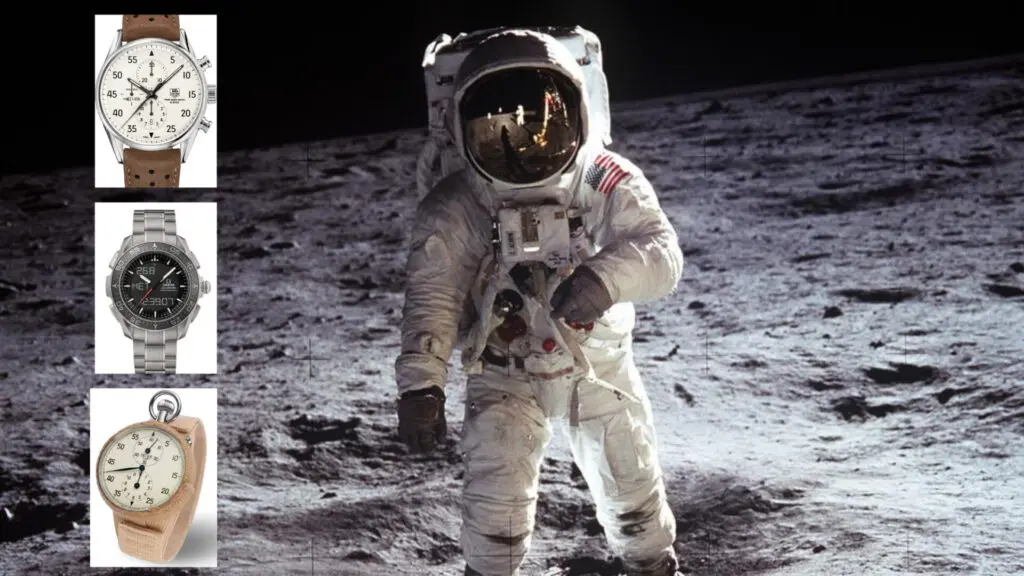2023 marks 62 years of the foremost manned mission to space. In 1961, humanity embarked on its journey to the stars and beyond. Since then, the purpose of every mission, its outcomes, scientific and historical implications, and equipment that made it possible have captured the imagination of people. Over the years, none of them has captured the popular imagination as much as a humble wristwatch has. You heard that right! It may be because watches are familiar to everyone who may or may not be interested in space travel. As wrist-worn, rugged tools, watches have quite a long history of accompanying trailblazers and adventurers to some of the most challenging places on the planet. Watches are seen to join explorers on their expeditions to the topmost of Mount Everest to the Marianas Trench’s bottom as well as to both poles over the decades.
However, for a watch, the greatest test comes when they entirely leave the planet. In outer space, several watches have been worn by astronauts- if not hundreds and by rounding up the best of them, we wished to give them their due. In this article, we have taken a close look at space exploration’s history, where every mission has involved one watch in some way or another. Some watches, most particularly the Omega Speedmaster Moonwatch- base their entire identity largely around their out-of-this-world experience, whereas others are more obscure. Later Omega watches were recognized by Soviet cosmonauts, including Omega Flightmaster. Here, we have compiled a list of some space watches that have the most significant value in the history of cosmic exploration. But before that, here we have presented a bit of history on the watches that have been to space.
A Brief History On The Space Watches
The foremost watch worn in space might not have been worn by a human even. The POBEDA 34-K Soviet-made wristwatch allegedly was strapped to the leg of Chernushka, a Russian dog, during his journey in March of 1961 on Sputnik 9. A Soviet cosmonaut, Yuri Gagarin, was the first human in space to complete one orbit around the Earth on April 12, 1961, aboard the Vosto0k 1 capsule. While Gagarin wore a watch- supposedly a Russian-made Stunmanskie, we are unaware what was actually strapped to his wrist. Therefore, for the first long-established, human-worn outer space timepiece, we need to head to the U.S. and the great late John Glenn. Glenn did not wear a traditional timepiece that told the time. Rather, he wore one Tag Heuer 2915A stopwatch that was straddling on a strap while he became the foremost American to reach the earth’s orbit on February 20 1962. A proper wrist watch that was worn the first time by one American astronaut happened only a few months later on 24th May 1962, when Scott Carpenter was wearing one 24-hour custom Breitling Navitimer that was specially designed for the space program where he flew on the Mercury-Atlas 7.
Any of these watches were rigorously tested for use in outer space, let alone intended for it. In 1964, NASA put out a call to some of the wristwatch manufacturers who were in search of wrist-worn chronographs. Then Omega submitted its new Speedmaster Professional, a part of a line of motorsport watches that debuted in 1957, along with chronographs from Longines, Hamilton, and Rolex. Only Omega managed to pass all the rigorous trials of the space agency, thereby earning the official designation of NASA for being qualified for flight for all managed space missions. After that, beginning in 1965, it flew with NASA astronauts in the Gemini program, becoming the foremost watch worn on the moon. This was when Buzz Aldrin set foot on lunar space on July 21 1969, during the Apollo 11 mission. It continues to be the timepiece most associated with space exploration. Neil Amstrong, the American astronaut, was the first to set foot on the surface of the moon wearing the Speedmaster. Let’s look at the watches.
List Of Watches Worn In Space
1. SEIKO 6139-6005 “POGUE”
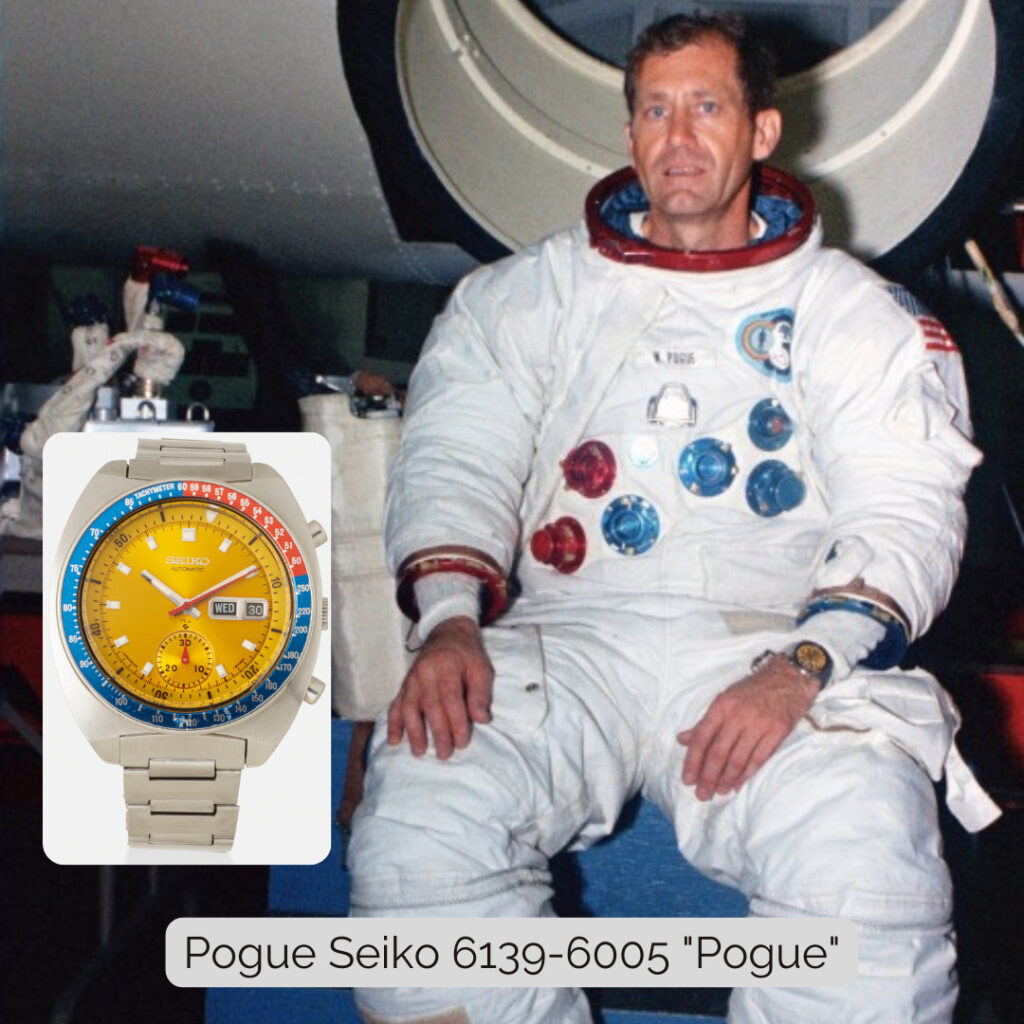
With its Pepsi bezel and golden dial, the Seiko’s 70s chronograph is among the funkiest to ever leave the atmosphere of the earth. William Pogue, the NASA astronaut, owned one of these watches personally. He trusted it so much that he took this piece with him without approval from NASA as a part of the three-man crew in 1973 aboard the Skylab 4 mission. With the Seiko, Pogue spent 84 days on the mission and allegedly used it for some timing duties after a crystal popped out of his Speedmaster. Thanks to Pogue, this 6139 became the foremost automatic chronograph to be in space, and in the decades since, this watch has adopted his name unofficially as its own.
- Water Resistance: 70 meters
- Diameter: 41 x 46 mm
- Release Year: 1969
- Price: $750+
2. Glycine Airman
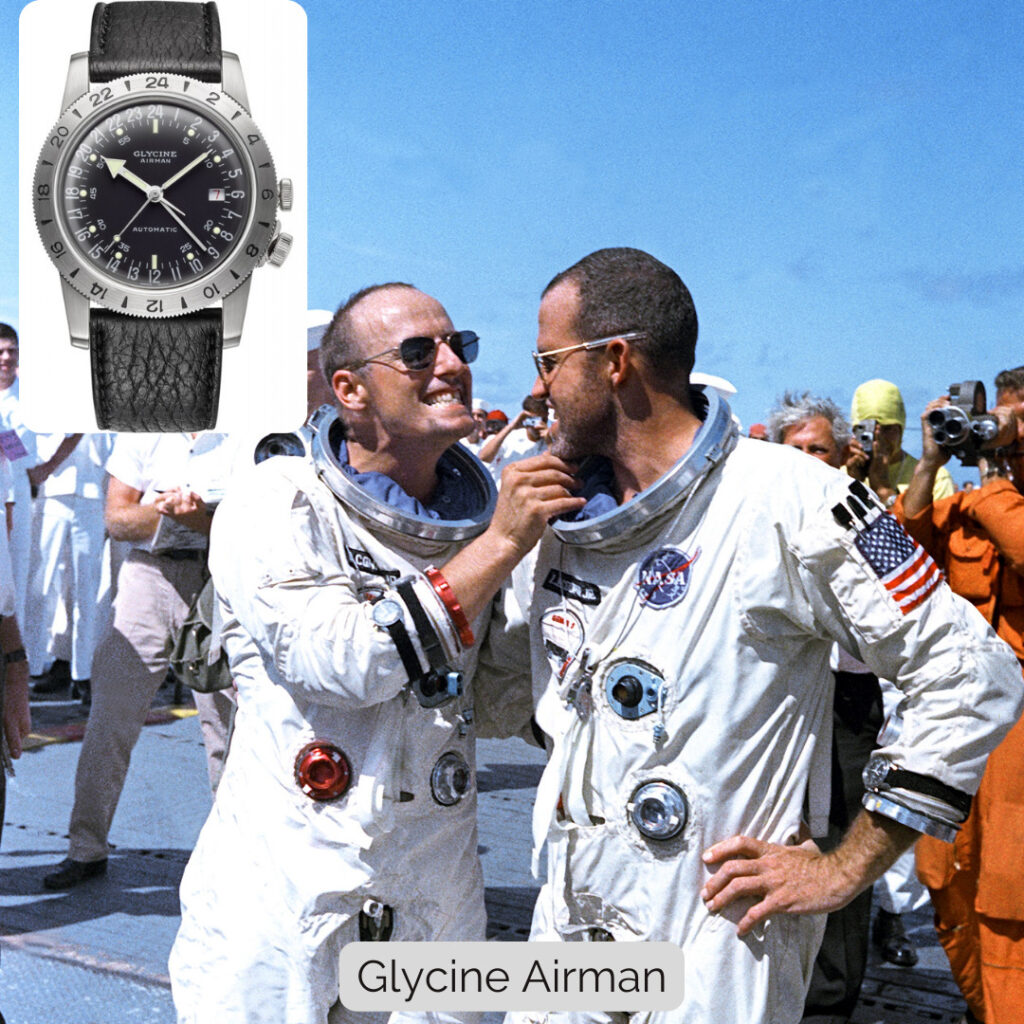
The Glycine Airman, even without its journeys to space, would still be one of the most prominent aviator watches in history. Pan-Am, in the early 1950s, called the watchmakers in the hunt for a timepiece that can track two time zones at once. It’s known that two brands came through. First, Glycine with the Airman and second, Rolex with its GMT Master in 1954. Glycine Airman was the first-ever watch for tracking a second-time zone on the 24-hour rotating bezel. The Airman, naturally popular with pilots, was a favorite of the test pilot and ensuing astronaut Charles Conrad, who wore the Glycerin during both his missions- the Gemini 5 mission in August 1965 as well as the Gemini 11 mission in 1966 September.
- Water Resistance: 50 meters
- Diameter: 42 mm
- Release Year: 1953
- Price: $908+
3. Sturmanskie Watch
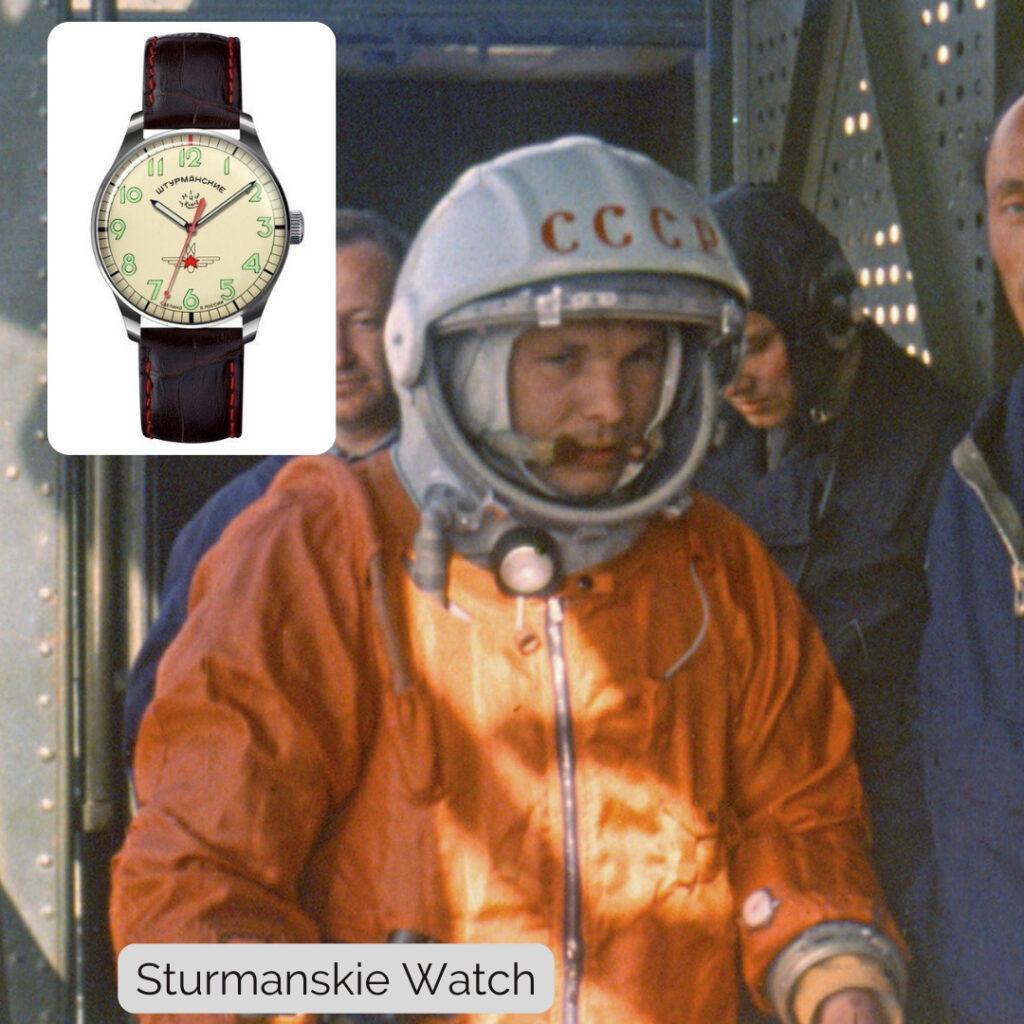
Apart from having the distinction of being the first nation to put a man in space, the Soviet Union also holds the distinction to make the first watch worn in space. In 1954, the Moscow Watch factory made the Sturmanskie as a specially issued watch for Soviet Air Force Pilot, Yuri Gagarint. This was recognized for its easy-to-read watch face with bold, big numbers arranged in the 12-hour format with sword-style hour and minute hands and a red seconds hand. Each Sturmanskie piece also had wings that implied flight along with the Red Soviet stat at the midpoint.
- Water Resistance: 50 meters
- Diameter: 40mm
- Release Year: 1949
- Price: $380+
4. Bulova Accutron Astronaut
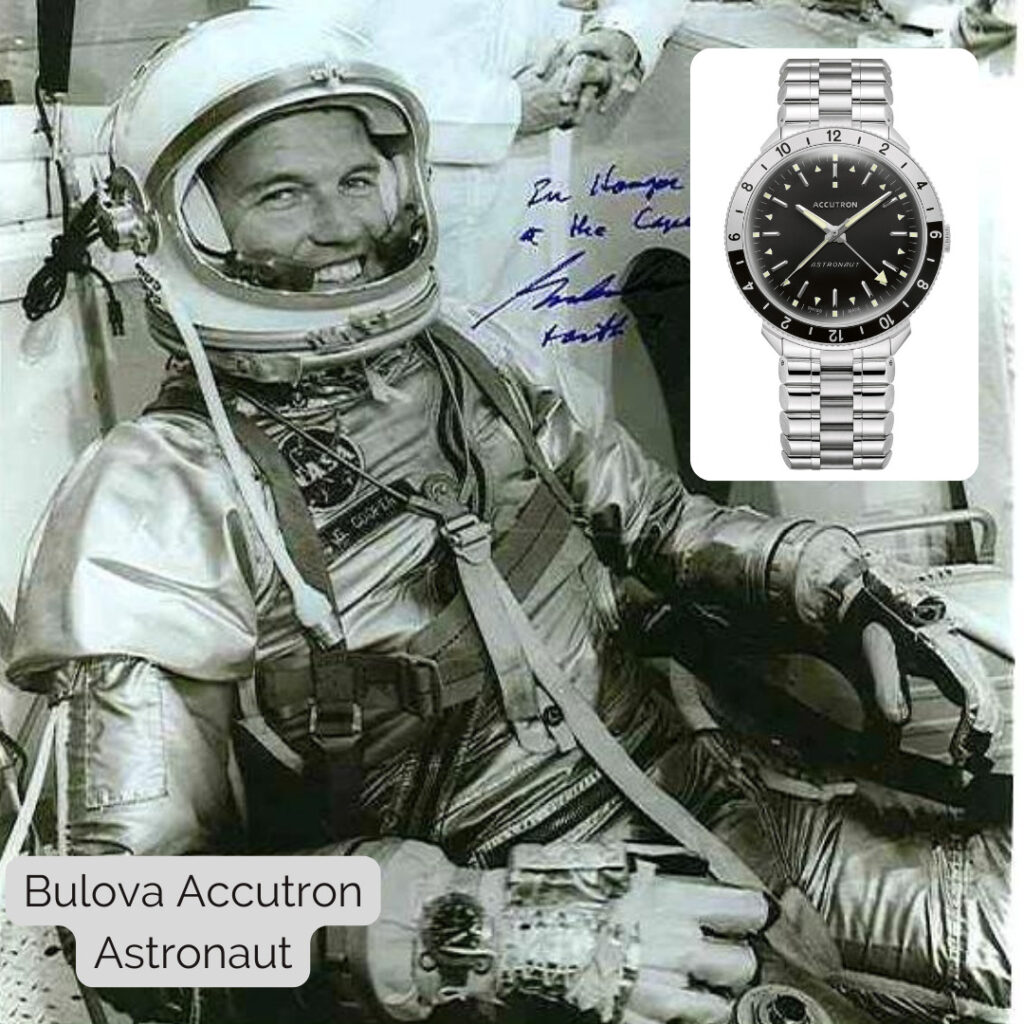
Before the desire of NASA for chronographs as well as the rise of the Omega Speedmaster, it definitely looked like the aptly-named Accutron Astronaut of Bulova were some of the world’s first electronic watches. The unique movement of the watch made it more resilient naturally to the high G-forces and extreme temperatures experienced at the time of spaceflight.
The U.S. Government agencies took notice. Accutron Astronauts, in the early 1960s, were given to test pilots of both the X-15 rocket plane of the Air Force, whose pilots flew high for qualifying for their astronaut wings and the famed A-12 spy plane of the CIA, the first aircraft that reached Mach 3. All Mercury 7 astronauts were subsequently issued the Accutron watches, and the early astronauts Virgil “Gus” Grissom, John Young, and Gordon Cooper, all sported them on missions with Grissom having borrowed his watch from astronaut Wally Schirra in 1965 during the training for Gemini 3.
- Water Resistance: 100 meters
- Diameter: 38 mm
- Release Year: 1962
- Price: $1250+
5. Timex Ironman NASA Missions
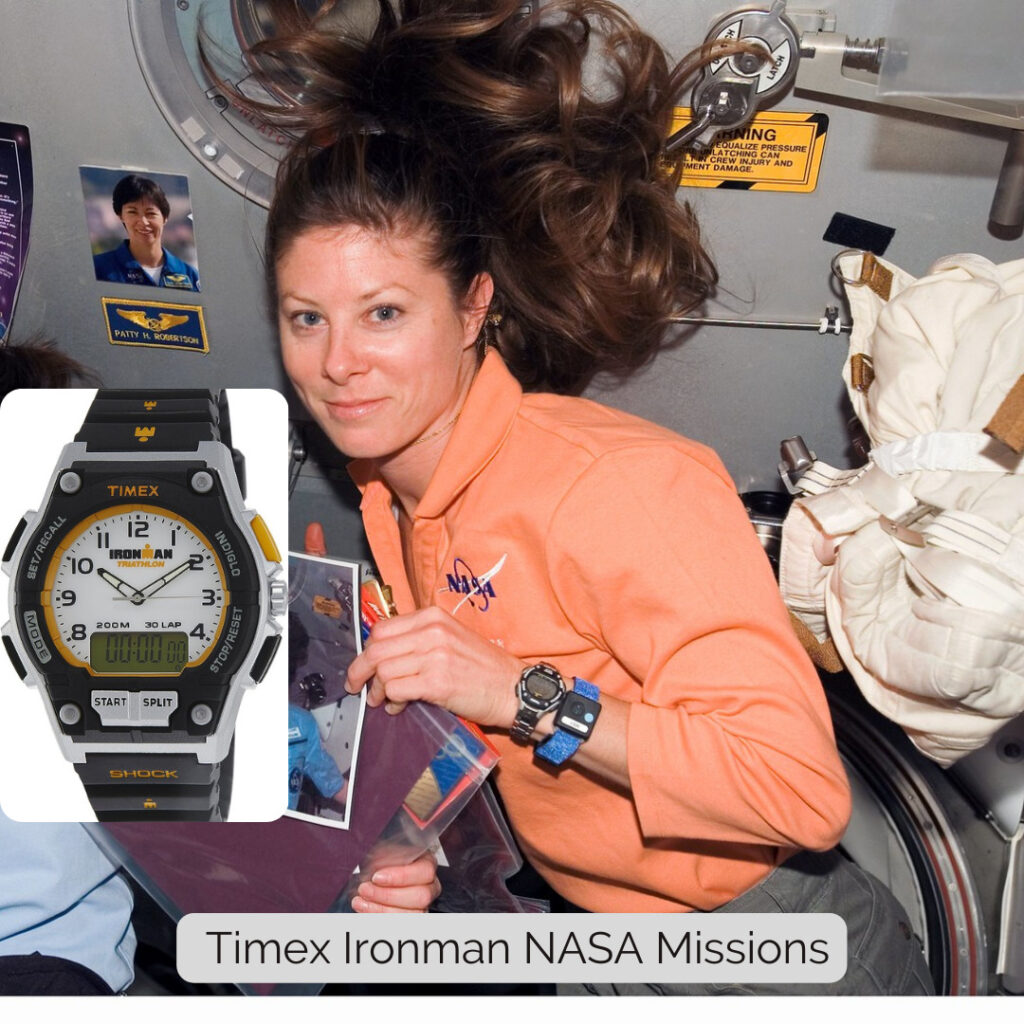
Same as the G-shock, The Ironman is a watch that has quite a reputation for its toughness. Due to this, it was selected by astronauts and has been certified by NASA for their space missions. It has accompanied Russian cosmonauts and astronauts to outer space. From Timex Sponsorship of the event of Ironman Triathlon came the eventual partnership as well as the acquiring of the rights to use the name of Ironman in 1986. It is very famous among sporting enthusiasts because of its rugged design, as the Ironman has since become the flagship watch of the company and the best-selling sports watch in the world.
- Water Resistance: 100 meters
- Diameter: 41 mm
- Release Year: 1986
- Price: $129
6. Fortis Cosmonauts Chronograph

While the Speedmaster of Omega has long been sanctioned for space missions officially by NASA, it has never been designated as the official space watch of the agency. In fact, in the world, there is only one official space watch, and it is the Fortis Cosmonauts Chronograph. The Swiss-made tool watch could clear all tests over six months by the space agency of Russia, ROSKOMOS, and in 1994, was awarded an exclusive twenty-five-year contract as the official space watch of the agency.
On the space stations ISS and MIS, it logged countless hours in the ensuing quarter-century. The contract of Fortis with ROSCOSMOS ended in 2019, supposedly for the best because no company at the moment wished to be associated with Russia. However, the brand continued its space-faring ways. Fortis has partnerships with the Swedish Space Corporation and the Austrian Space Forum and is the official timekeeper of the forthcoming AMADEE Mars Missions. Also, in 2022, Fortis released a new Stratoliner Chronograph that houses its WERK 17 caliber, the foremost watch movement that was ever tested in outer space.
- Water Resistance: 200 meters
- Diameter: 42mm
- Release Year: 1994
- Price: $3150
7. Sinn 140

Sinn, the German watchmaker, is famous for manufacturing some of the most rugged tool timepieces in existence. Naturally, the timepieces of the brand have been for years a favorite among astronauts. Though a few different models of Sinn have been to space, the most broadly associated with the final frontier is this Sinn 140, referred to colloquially by the brand as “Space Chronograph”. Reinhard Furrer, the German astronaut and physicist, wore his personal 140 S watch in 1985 during the D1 Spacelab, where he could observe how weightlessness affected the automatic movement of the watch. This mission, notably, was the Space Shuttle Challenger’s last successful flight prior to its tragic destruction in January 1986.
- Water Resistance: 100 meters
- Diameter: 44mm
- Release Year: 1985
- Price: $4880+
8. Tag Heuer Carrera 1887 Spacex
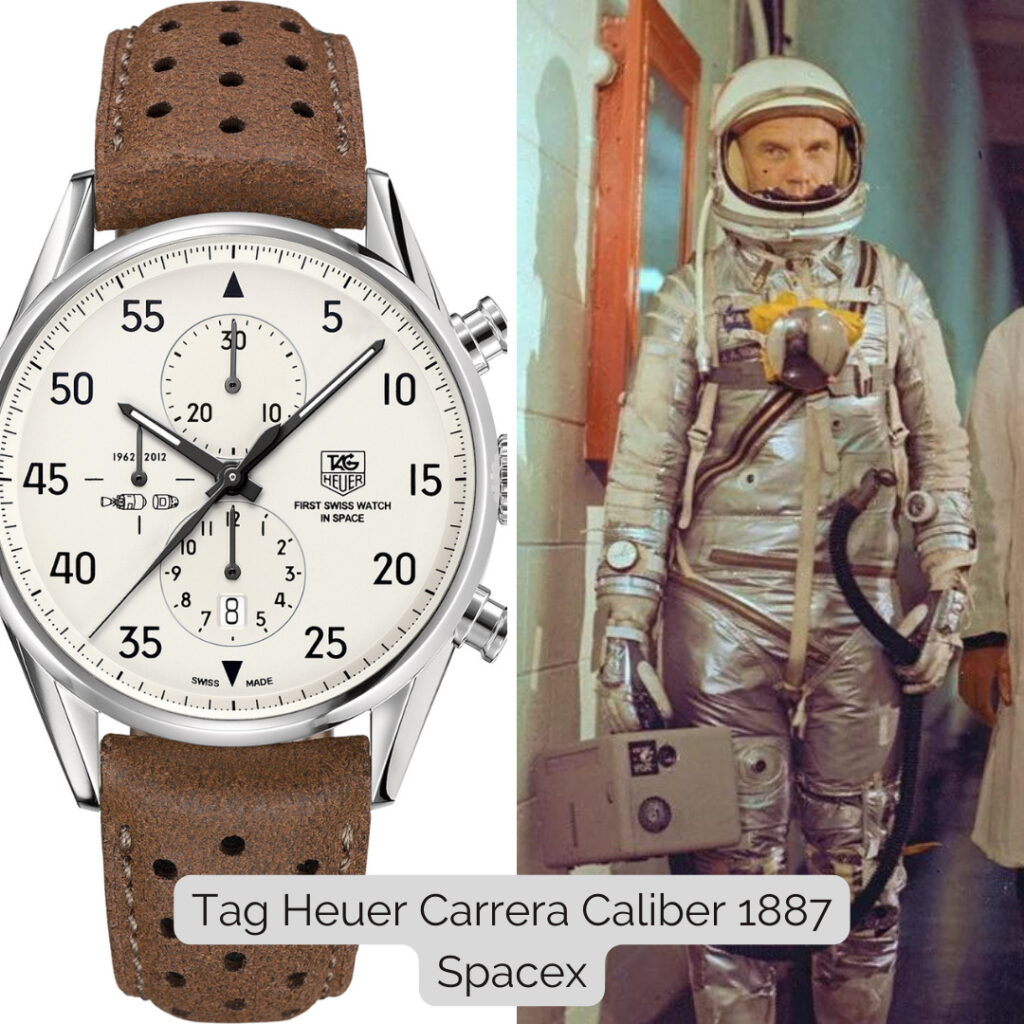
To commemorate John Glenn’s 50th anniversary of becoming the first American in outer space, in 2012, TAG Heuer partnered with SpaceX to create a limited-edition chronograph inspired by the Heuer stopwatch that John had with him on his historic journey. This watch was manufactured for a fairly accurate and wearable recreation of the foremost Swiss watch that was worn in space, but this was not just an homage. The piece managed to make its own history, as it was tested on the Dragon capsule of the board SpaceX, which became the first commercial spacecraft that ever visited the ISS in May 2012. Famous personalities who love Tag Heuer pieces include Brad Pitt, Matt Damon, Leonardo DiCaprio, Barack Obama, Tiger Woods, and Will Smith.
- Water Resistance: 100 meters
- Diameter: 43mm
- Release Year: 2012
- Price: $4953+
9. Omega Speedmaster X-33
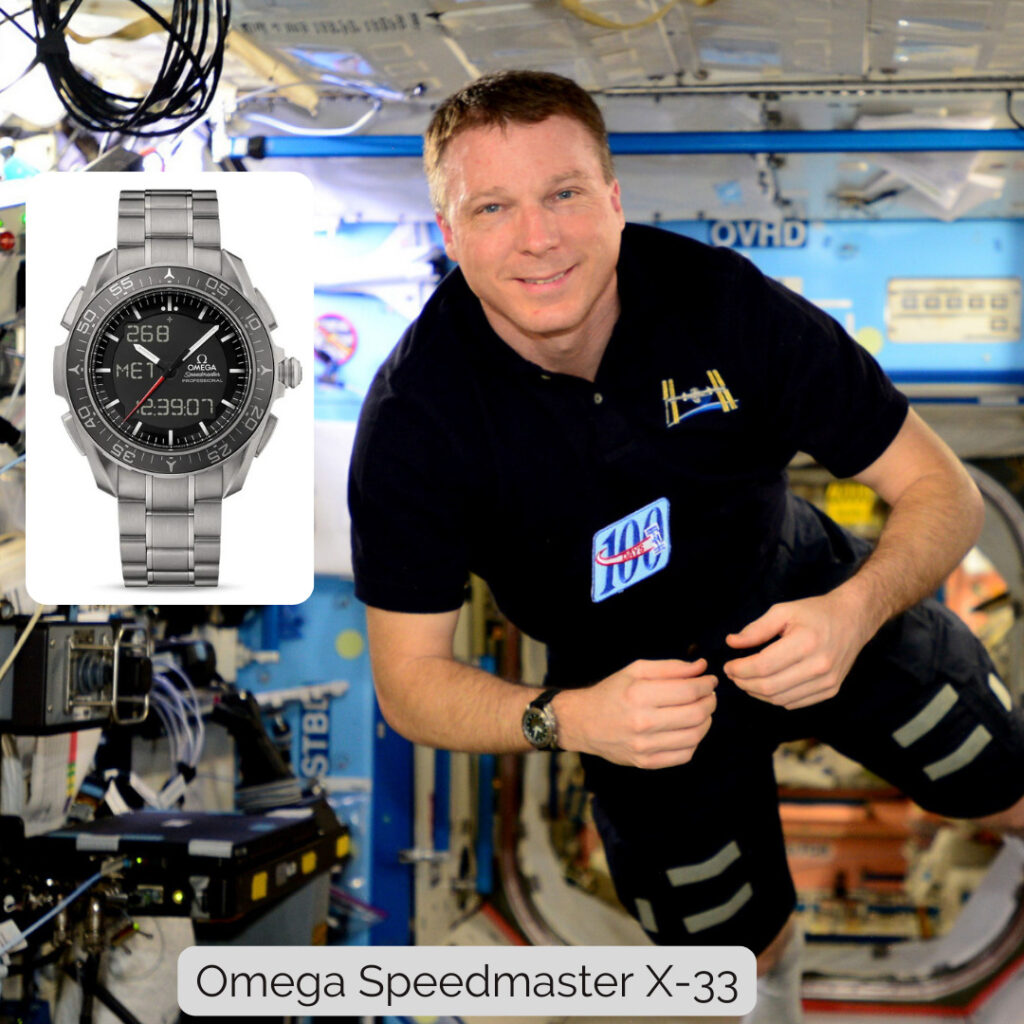
Omega, in the 1990s, set out to design a pretty modern Speedmaster that will accompany a manned mission to Mars. The Swiss manufacturer spent five years developing the watch with astronauts from all over the world. In 1998, the original X-33 was released. This open-powered watch featured an LCD display, a Kevlar strap, and a titanium case, and it was loaded with astronaut-desired functions such as elapsed time measurements for up to 1,000 days of missions and extra-strong lighting. The digital display offers self-programmable professional pilot functions and dates, two time zones, UTC, a countdown timer, and a chronograph function.
Designed for use while wearing astronaut gloves, this watch was worn on dozens of space station and Space Shuttle missions, but with consumers, it proved to be a flop and was discontinued. In 2014, however, Omega brought back this X-33 as the new Skywalker X-33. Arguably, sporting a more portable appearance and a movement qualified, developed, and tested by the European Space Agency, this new X-33 has been recognized to have greater staying power than its original one. Like its predecessor, with astronauts and flies on many, it has been a major hit. Notable people wearing Omega Speedmaster include Daniel Craig, Simon Pegg, Mark Knopfler, Denis Quaid, Tom Hanks, Steve Carell, Adam Savage, Ryan Reynolds, James Corden, and Bill Paxton.
- Water Resistance: 30 meters
- Diameter: 45mm
- Release Year: 1998
- Price: $5,900
10. Omega Speedmaster Professional

So far, the most famous space watch is Speedmaster of Omega, who journeyed to the great beyond before the presence of the version that will come to be recognized as the Moonwatch. Wally Schirra, the NASA astronaut, wore his personal Speedmaster watch with ref. no. CK 2998 on board the Sigma 7 aircraft on October 3 1962, during the mission Mercury-Atlas 8. After two years, another Speedmaster reference will be deemed appropriate for manned space flights by NASA with ref. 105.003, later referred to as ‘Ed White’ after the astronaut who wore it in 1965 during the first American spacewalk and five years later the Speedy left his mark on the moon’s surface.
Speedmaster Professionals, also known as Moonwatches, have been seen on the wrists of astronauts for every six manned moon landings of the Apollo program, thus leaving no doubt that this watch is well deserving of its moniker. Also, the Speedmaster played a vital role in 1970 during the harrowing Apollo 13 mission. After an explosion that occurred on the service module, that mission could not make it to the moon, and the crew shut down the ship’s system to conserve power to make it home. The astronauts, without digital timing instruments, famously used their Speedmasters to time the 14-second engine burns manually to splash down back on earth and avoid total disaster. While there isn’t any official registry to go off, the flagship watch of Omega has almost definitely been won in space much more than any other piece.
- Water Resistance: 50 meters
- Diameter: 42mm
- Release Year: 1957
- Price: $6,000
11. Breitling Navitimer Cosmonaute
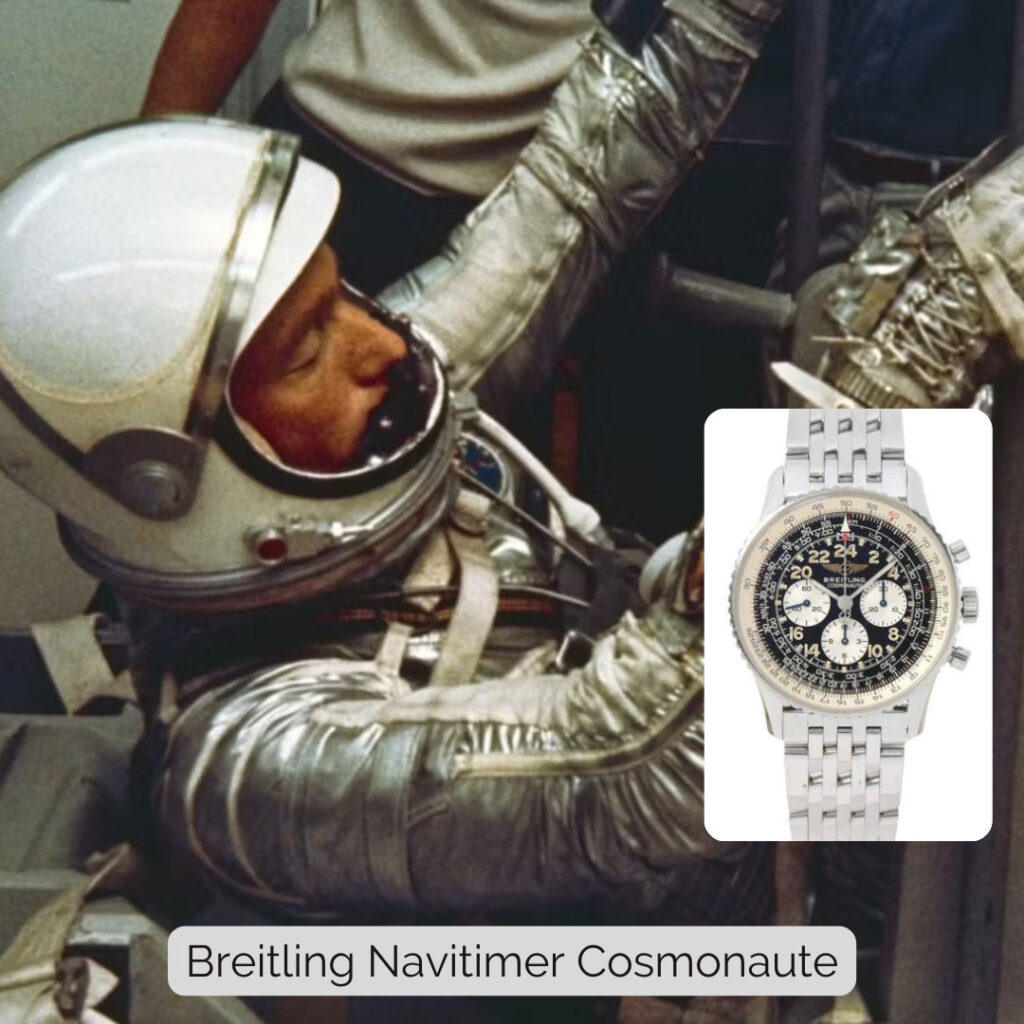
As mentioned above, the foremost confirmed wristwatch that was worn by an individual in outer space was the custom-made “Cosmonaute” Navitimer by Breitling, which Scott Carpenter wore in 1962 during his Mercury-Atlas 7 mission. Manufactured by Breitling to the specific requests of Carpenter, the Cosmonaute received a 24-hour dial to distinguish nighttime and daytime hours, a simplified slide rule bezel, as well as a wider bezel for a pretty operation with the gloves. In space, Carpenter’s Breitling performed admirably but was ruined by the water damage as in the Atlantic, and the astronaut splashed down. Breitling released a 362-piece limited edition reissue of the Cosmonaute in 2022, recreating the functionality and look of the original chronograph faithfully but adding luxurious and modern upgrades like a sapphire display case back and a platinum bezel. Some of our favorite celebrities who wear Breiling watches include Gordan Ramsey, Tom Cruise, Bear Grylls, Brad Pitt, John Travolta, and David Beckham.
- Water Resistance: 30 meters
- Diameter: 41mm
- Release Year: 1961
- Price: $11,200
12. Rolex Gmt-Master 1675

The second-generation GMT-masters especially were prevalent during the Apollo moon missions. This isn’t surprising given that arguably it was the best pilot’s wristwatch of its day- with astronauts Ronald Evans from Apollo 17, Stuart Roosa and Edgar Mitchell from Apollo 14, and Jack Swagger from Apollo 12, all having worn their own Rolex Pepsis on their most popular missions.
There are even rumors that Swiger actually used his Rolex to time the critical engine burns of Apollo 13. While these rumors are believed to be just rumors largely, there is much better evidence that one Rolex GMT-Master had made it to lunar surface in Evans’ 1675, having made the trip after he gave it to his fellow space explorers Harrison Schmitt and Gene Cernan while they descended to the moon when he continued orbiting in the command module.
- Water Resistance: 100 meters
- Diameter: 39mm
- Release Year: 1959
- Price: $12,000+
13. Bulova Lunar Pilot Limited Edition (50th Anniversary)
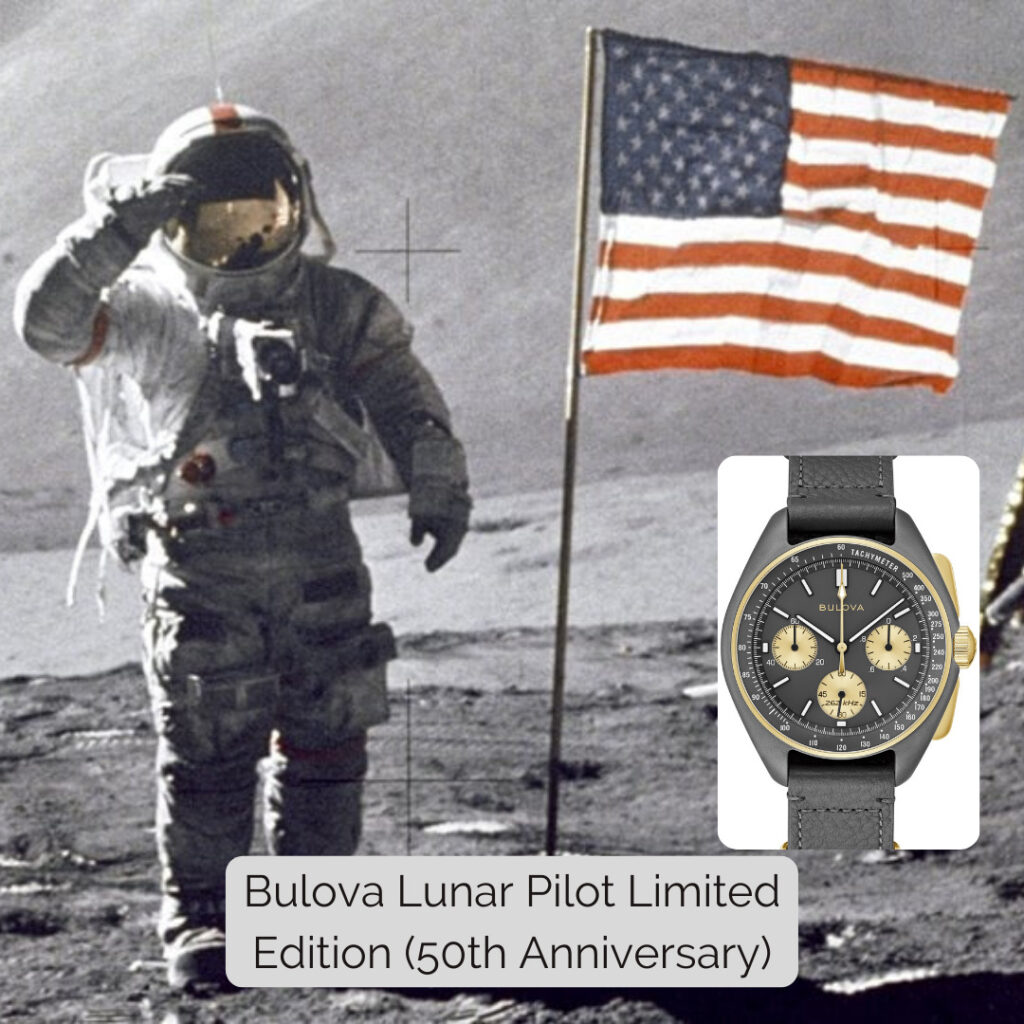
This Bulova Lunar Pilot Moonwatch is far from the sole timepiece, having a connection to the cosmos. Rather, it is not even the one that made itself to the moon. Dave Scott, the U.S. astronaut in 1971, during the Apollo 15 mission, wore a Bulova chronograph. This watch has given him a rich seam for mining with its stylish retro tribute timepiece, the Lunar Pilot. In light of Apollo 15’s 50th anniversary, a bold new limited-edition watch, in titanium having gold accents, was launched. Powered by a quartz movement, it is an affordable and quirky challenger to the Omega’s space watch.
- Water Resistance: 50 meters
- Diameter: 45mm
- Release Year: 2021
- Price: $1799+
14. Seiko Spring Drive Spacewalk
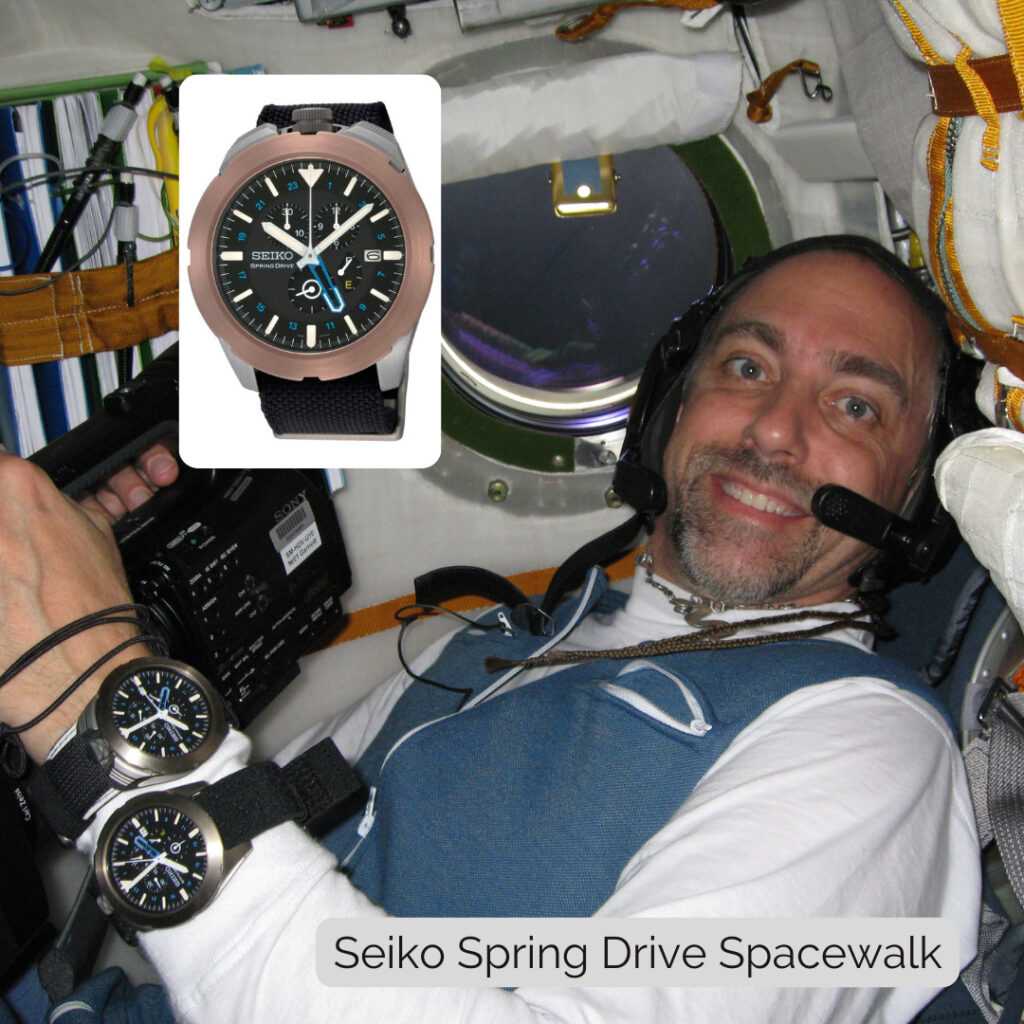
The Seiko Spring Drive Spacewalk was designed and built specifically to accompany the first private person to conduct a spacewalk. Seiko wished to become involved with developing a Spacewatch due to the technical challenges it presented. For the Seiko engineers, the challenge was creating a space watch that could have accurate timekeeping, be comfortable and reliable and withstand the harsh environments of space flight and spacewalk. Seiko decided to use a spring drive movement as it is less affected by extreme temperatures because of its Tri-synchro Regulator, which is different from a traditional regulator. The watch’s mechanism provides functions like- seconds, minutes, hours, GMT, calendar, 12-hour chronograph, and 72-hour power reserve.
- Water Resistance: 100 meters
- Diameter: 53mm
- Release Year: 2008
- Price: $100,000
15. Tag Heuer Stopwatch Friendship 7
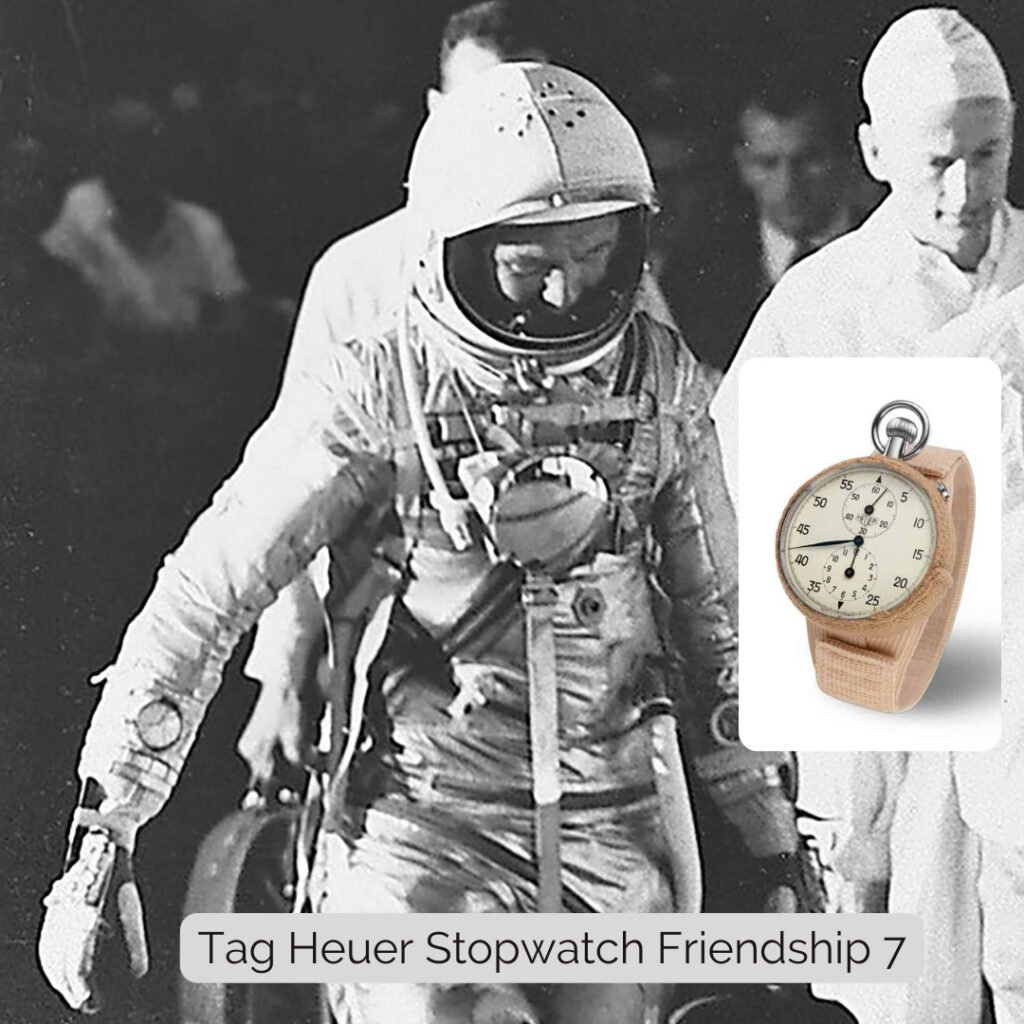
John Glenn was the foremost American to orbit earth, and he wore one Tag Heuer Stopwatch which was modified with elastic bands to provide fit over the spacesuit. For the timing instruments aboard the Friendship 7, the Heuer stopwatch served as one ‘backup clock’ and was manually started by Glenn 20 seconds into the flight. Currently, it is on exhibition at the San Diego National Air and Space Museum.
- Water Resistance: 50 meters
- Diameter: 45mm
- Release Year: 1962
- Price: $6,000
What Watches Were Worn In Space?
Space exploration has always engrossed public interest and attention. The watches of the foremost cosmonauts to date remain an object of intense curiosity. Space exploration and watch production have often been connected closely. New models were created for honoring new achievements or specifically produced for upcoming space missions. Some of the famous watches that were worn to space include-
- Seiko 6139-6005 “Pogue”
- Glycine Airman
- Tag Heuer Carrera Caliber 1887 Spacex
- Omega Speedmaster X-33
- Omega Speedmaster Professional
- Breitling Navitimer Cosmonaute
- Rolex Gmt-Master 1675
- Bulova Lunar Pilot Limited Edition (50th Anniversary)
- Seiko Spring Drive Spacewalk
- Tag Heuer Stop Watch Friendship 7
- Sturmanskie Watch Bulova Accutron Astronaut
- Timex Ironman Nasa Missions
- Fortis Cosmonauts’ Chronograph
- Sinn 140
From the Writer
The history of space watches arrays from modern residents of the International Space Station to the Russian cosmonaut programs. They are designed with a broad spectrum of functionality. However, the concept of space has left its aesthetic mark on the watch design also. In this article, we have looked at major historical milestones and connected specific watch models to the time they were used. When talking about some particular watch models that have gone to space, these models have a particular cachet like they were durable enough for some of the extreme environments that a human can experience. Owning one offers a cool feeling of connection to cosmonauts and astronauts. So, what is your favorite space watch?

